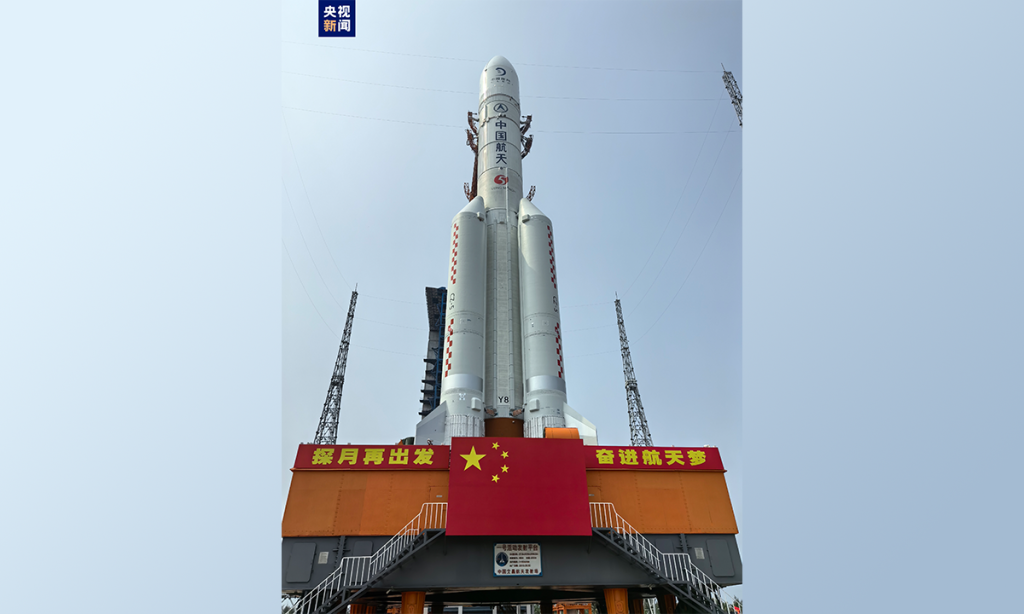China will launch Chang'e-6 lunar probe in early May to collect samples from far side of the moon

The Chang'e-6 lunar probe and the Long March-5 Y8 carrier rocket combination has been vertically transported to the Wenchang Space Launch Site in South China's Hainan Province. The launch is scheduled to take place in early May, the Global Times learned from the China National Space Administration (CNSA) on Saturday.
After arriving at the launch site in January and March respectively, the Chang'e-6 lunar probe and the Long March-5 Y8 carrier rocket have successively completed assembly, testing, and other preparatory work, CNSA said in the statement.
Subsequently, various functional checks, joint tests, propellant loading, and other tasks will be carried out according to the plan.
The mission will be the world's first ever attempt to collect material from the dark side of the moon and return it to Earth for further study.
The scale of such samples retrieved from the moon would be around 2,000 grams, Wu Weiren, chief designer of China's lunar exploration program, previously revealed. The epic Chang'e-5 mission retrieved 1,731 grams.
The US has been desperate to get its hands on these precious samples. Sidestepping the Wolf Amendment, for the first time, NASA has greenlit space agency-funded researchers to apply for access to China's lunar samples returned to Earth via Chang'e-5. It said in a statement that the samples are "expected to provide valuable new scientific insight on the geological history of the moon, which could provide new understanding of the Earth-moon system and potentially inform NASA's future lunar exploration plans."
As part of the key constellation supporting the Chang'e series of lunar exploration tasks, China launched the Queqiao-2 relay communication satellite on March 20 for communications between the far side of the moon and the Earth. Some 20 days later, the CNSA announced the complete success of the Queqiao-2 mission after it completed a series of in-orbit communication tests.
The Chang'e-6 mission is part of China's Phase-4 lunar exploration program, which will carry out new planetary exploration missions and further upgrade the country's space launch capabilities in the next 15 years. Landing a Chinese national on the moon is expected to happen before 2030.
Wu disclosed on this year's China Space Day that the International Lunar Research Station (ILRS), co-led by China and Russia, will be built in two phases, consisting of sections on the lunar surface, the lunar orbit and on Earth.
The first phase of the ILRS construction project will see a basic station built by 2035 in the lunar south pole region, equipped with comprehensive scientific facilities with complete basic functions and supporting elements to carry out regular scientific experiments.
The second phase will see expansion of the station, set for completion by 2045, with a moon-orbiting space station as the hub and facilities featuring complete functions.
Three new members - Nicaragua, the Asia-Pacific Space Cooperation Organization, and the Arab Union for Astronomy and Space Sciences - signed up for the ILRS program, as announced by CNSA on Wednesday.
So far, nearly 20 countries and organizations have joined the ILRS, including US Hawaii-based International Lunar Observatory Association, Swiss company Nano-SPACE for Cooperation, and France's Thales Group.
China will welcome 50 countries, 500 international research institutions and 5,000 overseas researchers who will join the ILRS program, according to the CNSA.
Wu also disclosed China's ambitious Mars plan. "China plans to launch the Tianwen-2 mission around 2025 to conduct a flyby exploration and sample return from a small asteroid about 40 million kilometers from Earth. Around 2030, the Tianwen-3 mission is planned to be launched to carry out a Mars sample return mission," said Wu. " China is expected to become the first country to return samples from Mars."